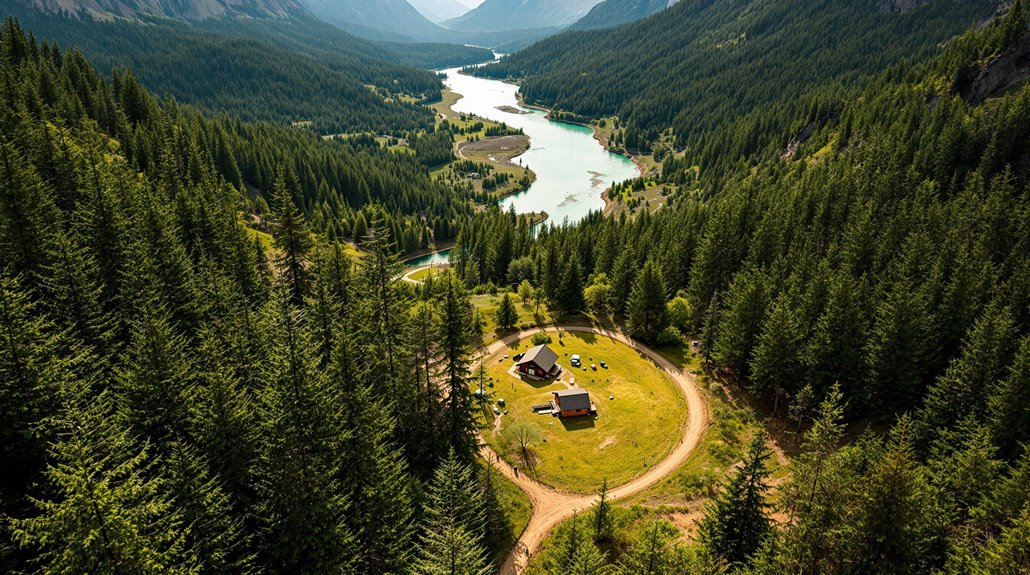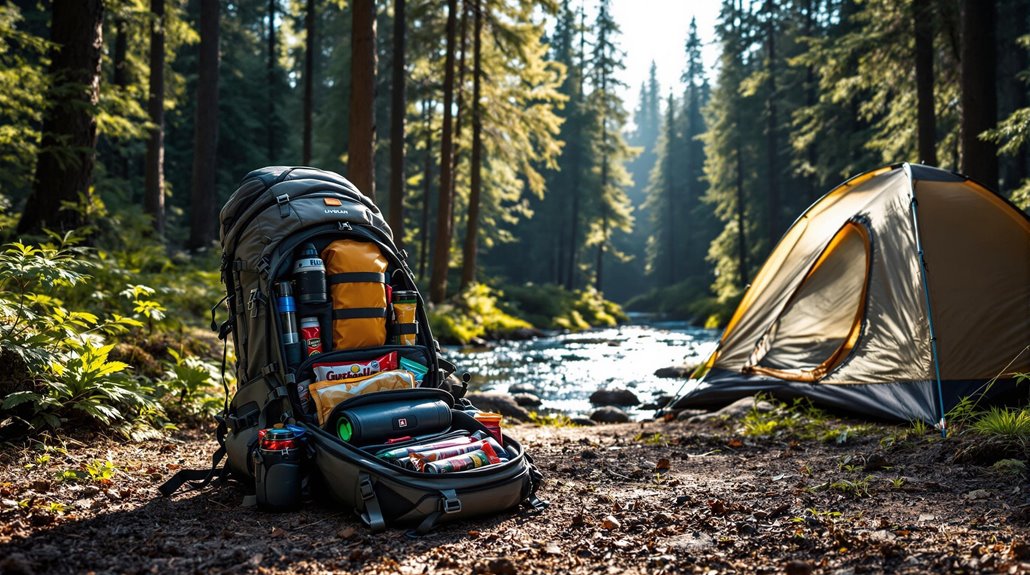How to Choose the Perfect Bug-Out Location

To choose the perfect bug-out location, look for a spot 50-70 miles from urban areas to avoid threats. Verify a reliable water source; you'll need at least a gallon per person daily. Fertile land is crucial for growing food, and agricultural zoning is a must to stay legal. Natural barriers improve security, and multiple escape routes should be planned. Familiarize yourself with local climate and resources, like wildlife and firewood, for sustainability. Confirm existing structures are sturdy and manage waste efficiently. Preparing properly means you can boost your chances of thriving during emergencies. Investigate further to deepen your strategy.
Understanding Bug-Out Locations
Understanding bug-out locations is important for anyone preparing for emergencies. A bug-out location (BOL) acts as your emergency retreat, providing shelter and safety away from your primary residence during crises. When selecting a BOL, focus on fundamental characteristics that guarantee its effectiveness. One key element is a reliable water supply. You'll need access to clean, sustainable water sources for drinking, cooking, and hygiene. Without it, surviving long-term becomes challenging. Consider ensuring your BOL is equipped with water purification methods to maintain a sustainable water supply in emergencies. Rural areas often make ideal bug-out locations due to their seclusion from urban threats. Being 50-70 miles away from cities can help you avoid congestion and maintain safety during mass evacuations. These areas usually offer natural resources and opportunities for sustainable living, such as gardening and food storage. It's important that your BOL is accessible, allowing you to reach it quickly in an emergency. Additionally, consider the defensibility of your chosen location. You want to make sure that it's secure against potential intruders. Remember, a well-chosen bug-out location can provide peace of mind and a viable plan for unforeseen circumstances. By considering these aspects, you're better prepared to face emergencies with confidence.
Key Characteristics to Consider
When you're selecting a bug-out location, there are several key characteristics you should consider to secure your safety and survival. Initially, the location should be about 50-70 miles from urban centers. This distance helps you avoid initial chaos while still allowing a quick retreat. A crucial characteristic is water availability. Verify there's a reliable source, like a pond or well, providing at least 1 gallon per person per day. This covers drinking, hygiene, and food preparation needs. Security is another essential factor. Look for natural barriers and a concealed location to deter intruders. Incorporate perimeter defenses and have a solid plan for emergency exits. Familiarity with the terrain and local climate will improve your preparedness. Knowing the natural resources and potential hazards can make all the difference in a crisis. Lastly, focus on self-sufficiency. Your chosen land should support gardening or livestock, securing long-term food security. There must also be adequate space for storing supplies and resources. By considering these characteristics, you'll be well on your way to selecting a bug-out location that guarantees both safety and sustainability in an emergency.
Accessibility and Safety Routes

Finding your bug-out location (BOL) is a significant part of your emergency preparedness plan. Prioritize accessibility and safety routes to guarantee you can reach your BOL quickly and safely. Ideally, your BOL should be 50-70 miles from your primary residence, accessible within a few hours by car or a few days by foot. This distance strikes a balance between accessibility and seclusion, keeping you away from immediate threats yet reachable in a crisis.
Plan multiple alternative routes to avoid congested highways and main roads, which can become bottlenecks during emergencies. Use topographic maps to assess geographic features that aid or hinder your escape routes. This way, you can find paths that are defensible and less likely to attract unwanted attention. Staying informed about local emergency services and infrastructure helps you anticipate roadblocks or closures, providing quick access when it matters most.
Consider locations near natural water sources, as these can be essential for survival. Check for existing structures that could offer immediate shelter and security. Regularly practice your routes to familiarize yourself with the terrain and identify potential challenges, reinforcing your readiness for any situation. To enhance your overall preparedness, engage in skill-sharing workshops that can improve your survival techniques and help you build a network of knowledgeable individuals.
Evaluating Natural Resources
In selecting a bug-out location, a primary consideration should be its proximity to reliable natural water sources. Look for streams, lakes, or ponds because water is vital for drinking, hygiene, and food preparation. Aim for a supply of at least one gallon per person per day. This guarantees you can maintain basic needs without relying on unpredictable weather patterns.
Next, evaluate the availability of fertile land. Rich, loamy soil is ideal for gardening or farming, providing a sustainable way to grow your own food. This is especially significant if a natural disaster disrupts supply chains. Check soil quality thoroughly; healthy soil can be the difference between a thriving garden and a barren patch.
Wildlife presence is another key factor. Abundant game like deer, rabbits, and fish offers vital food sources. This can be a lifeline in emergencies where traditional food supplies are scarce. Also, consider the availability of natural resources like firewood. A nearby wooded area provides a sustainable source of fuel for heating and cooking.
Finally, investigate local climate conditions and seasonal patterns. Understand how these factors affect resource availability, like rainfall for water collection or growing seasons, to guarantee your bug-out location remains viable. Preparing coolers with ice packs in advance is crucial for maintaining food freshness during power outages.
Ensuring Long-Term Survival

Securing your long-term survival at a bug-out location hinges on careful planning and strategic resource management. Begin by guaranteeing access to reliable water sources like streams or ponds, as you'll need at least one gallon per person daily for drinking, hygiene, and food preparation. Without adequate water, sustaining life becomes nearly impossible.
Next, evaluate the soil quality and sunlight exposure in your chosen area. These factors are vital for successful gardening, which is key for sustainable food sources and self-sufficiency. Growing your own food not only improves food security but also reduces dependency on external supplies. Consider integrating a survival garden to ensure a self-sufficient supply of nutrient-rich vegetables and protein sources, enhancing your overall resilience during emergencies.
Defensible terrain is another important consideration. Look for raised ground or natural barriers that can provide protection against intruders and wildlife threats. This strategic advantage secures your safety, allowing you to focus on other survival tasks.
Incorporate a thorough survival plan that includes growing food, raising livestock, and foraging for wild edibles. Techniques like greenhouse growing and aquaponics can optimize resource management. Furthermore, assess the availability of wildlife for hunting and fishing to maintain diverse food sources. This diversity is fundamental for food security during prolonged emergencies, ensuring you and your family can thrive.
Legal and Financial Factors
While guaranteeing long-term survival is vital, traversing the legal and financial landscape of your bug-out location is likewise significant. Understanding zoning laws is important, especially if you plan to engage in activities like gardening or keeping livestock. Agricultural zoning will guarantee compliance with local regulations, helping you avoid potential legal issues. Ignoring these could lead to hefty fines or restrictions that might derail your preparedness efforts.
Affordability is another key consideration. You'll want to focus on properties that fit within your budget to prevent financial strain. Prioritize fundamental features that cater to your survival needs rather than unnecessary luxuries. Researching government regulations and permits related to land use is also fundamental. This will help you anticipate and avoid future restrictions that could impede your plans.
Investment opportunities in rural areas are on the rise, particularly in the agricultural sector. These can offer not only a safe retreat but also potential income through farming or sustainable practices. Engaging professional assistance in property selection can help you navigate these legal complexities. A well-chosen property will align with both your survival and financial goals, making it a sound investment. Additionally, ensure that the property has reliable food and water supplies to support long-term sustainability and survival in case of emergencies.
Strategic Security Measures

Establishing strategic security measures is vital for ensuring the safety of your bug-out location. Start by creating a secure perimeter with a complete fence around your property. This not only deters unwanted intruders but also improves your privacy. Use natural barriers like hills, rivers, or dense vegetation to add an extra layer of security and concealment. These natural elements make it harder for anyone to approach unnoticed, giving you an advantage in protecting your space.
Next, fortify entry points such as doors and windows. Reinforcing them with strong materials like wood and nails increases their resistance to forced entry during emergencies. This simple yet effective step can make a significant difference in keeping your location safe from threats.
A hidden security camera system at your entrance is another important measure. It allows you to monitor activity and provides an early warning of potential threats. Make sure your cameras are discreetly positioned to avoid detection while offering a clear view of anyone approaching.
Lastly, maintain raised ground on your property to improve your visibility and situational awareness. This vantage point helps you detect any approaching dangers effectively, giving you ample time to respond appropriately. Integrating intrusion detection measures will further enhance your ability to monitor unauthorized access and secure your perimeter against potential intrusions.
Environmental and Structural Needs
After confirming your bug-out location is secure, it's time to focus on meeting the environmental and structural needs that support sustainable living. Start by evaluating the soil quality, as fertile soil is essential for successful gardening and sustainable food production. Poor soil can lead to food shortages, so it's imperative to verify it can support your needs.
Next, prioritize reliable access to water sources. Look for nearby streams or ponds and consider establishing rainwater collection systems. These will provide a sustainable water supply for drinking and hygiene, fundamental for long-term survival. Consider integrating water treatment methods such as filtration and UV sterilization to ensure the purity and safety of your water sources.
Examine any existing structures on the property or the potential for building new shelters. These should be resilient against local weather conditions and natural disasters, such as floods, earthquakes, or extreme temperatures. Your shelter should offer protection and withstand these challenges.
Additionally, plan for effective waste management by designating areas for biodegradable and non-biodegradable waste. This supports hygiene and sustainability, guaranteeing a clean and healthy environment.
Finally, familiarize yourself with the local terrain, climate, and natural hazards. Understanding these elements will help improve your survival skills and guarantee effective resource management during emergencies.
Preparing Essential Supplies

Getting ready for emergencies means you need to focus on preparing critical supplies that'll support you in a crisis. Start by assembling a thorough Bug Out Bag. Confirm it contains basics like at least one gallon of water per person per day and non-perishable food items to sustain you until you reach your bug-out location. A well-stocked Initial Aid kit is indispensable for handling injuries or illnesses when medical help isn't immediately available. Your Bug Out Bag should also include tools to maintain situational awareness and navigate effectively. Pack a portable radio and extra batteries, along with a map and compass. These items are key for staying informed and finding your way in unfamiliar terrain. During a blackout, having non-perishable food is essential, as refrigeration fails without power. Don't overlook shelter necessities. A multi-tool, tarps, and rope are important for constructing a temporary dwelling at your bug-out location. To maintain hygiene and health standards, add personal sanitation supplies and biodegradable bags for waste management. Finally, regularly review and update your supplies to confirm they meet current needs and remain effective. By doing so, you'll be better prepared to face any emergency with confidence and resilience. Remember, preparation is fundamental in confirming your safety and comfort during a crisis.
Planning for Emergencies
To effectively plan for emergencies, start by developing an all-encompassing survival strategy that outlines the vital supplies, tools, and equipment you'll need. This plan should address the unique challenges posed by potential disasters, especially if you're shifting from an urban area to a remote bug-out location. Here are some key steps to guarantee you're adequately prepared:
- Create a Detailed Inventory: List fundamental supplies like food, water, medical kits, and communication tools. Confirm your bug-out bag can sustain you for at least two weeks.
- Practice Evacuation Routes: Regularly rehearse different scenarios to familiarize everyone with the quickest and safest paths to your chosen bug-out location. This is significant in an urban area, where congestion can be unpredictable.
- Establish Emergency Protocols: Develop contingency plans that address risks such as isolation, adverse weather, and security threats. Clearly outline roles and responsibilities for each group member.
- Engage in Ongoing Training: Regularly improve your survival skills and build a support network with like-minded individuals to bolster your resilience.
- Ensure you have a communication plan in place to stay connected with family and emergency services during a disaster, which is crucial if traditional phone lines are disrupted.




